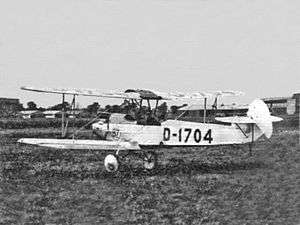Albatros L 82
| L 82 | |
|---|---|
 | |
| Role | Trainer |
| Manufacturer | Albatros Flugzeugwerke |
| First flight | 1929 |
| Primary user | Germany |
| Number built | 17 |
|
| |
The Albatros L 82 was a 1920s German trainer biplane. Of conventional configuration, it seated the pilot and instructor in separate, open cockpits. The wings were single-bay, equal-span, and unstaggered.
Operational history
The prototype and one production L 82b took part in the Challenge 1929 international contest, during which the prototype (D-1704) crashed on 10 August 1929 in Turnu Severin, pilot Karl Ziegler. The second example (D-1706) completed the contest in 27th place, pilot Werner Junck).[1]
Variants
- L 82a - prototype with de Havilland Gipsy engine
- L 82b - single example with Siemens-Halske Sh 13 engine
- L 82c - production version with Siemens-Halske Sh 14 engine
Specifications (L 82c)
General characteristics
- Crew: two, pilot and instructor
- Length: 7.41 m (24 ft 4 in)
- Wingspan: 9.00 m (29 ft 6 in)
- Height: 2.66 m (8 ft 9 in)
- Wing area: 20.0 m2 (215 ft2)
- Empty weight: 400 kg (880 lb)
- Gross weight: 750 kg (1,650 lb)
- Powerplant: 1 × Siemens-Halske Sh 14, 120 kW (160 hp)
Performance
- Maximum speed: 160 km/h (100 mph)
- Range: 560 km (350 miles)
- Service ceiling: 3,800 m (12,500 ft)
See also
Notes
- ↑ Marian Krzyżan: Międzynarodowe turnieje lotnicze 1929–1934, Warsaw 1988
Bibliography
- Taylor, Michael J. H. (1989). Jane's Encyclopedia of Aviation. London: Studio Editions. p. 56.
External links
| Wikimedia Commons has media related to Albatros L 82. |
This article is issued from Wikipedia - version of the 11/12/2016. The text is available under the Creative Commons Attribution/Share Alike but additional terms may apply for the media files.